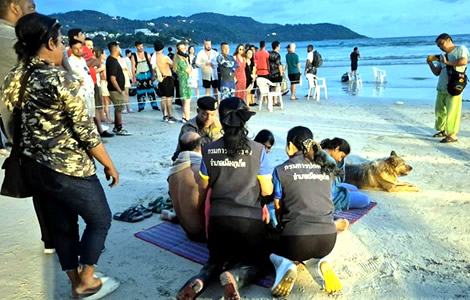A 10-year-old Canadian girl drowned at Phuket’s Kata Beach just one day after arriving for a family holiday. Despite rough surf and strong currents, no red flags warned swimmers. Her death highlights rising monsoon season dangers and urgent calls for better beach safety.
A 10-year-old Canadian girl has become the latest victim of Phuket’s treacherous monsoon seas, drowning just a day after arriving in Thailand with her family for a planned two-month holiday. The tragedy occurred at Kata Beach, where no red flags were visible at the time, despite reportedly rough conditions and strong waves. Eyewitnesses noted heavy surf, yet swimming continued. The girl’s death adds to a growing list of seasonal drownings that have raised serious concerns about beach safety during this year’s season.

PHUKET – A family holiday turned into tragedy on August 7 when a 10-year-old Canadian girl drowned at Kata Beach. The incident has renewed concerns over beach safety during Phuket’s dangerous monsoon season.
The Canadian family of five had just arrived in Phuket on August 6. They had flown in from Malaysia and planned to stay in Thailand until early October. However, their long-anticipated vacation ended in heartbreak just one day later.
At around 4 pm on Thursday, the family went swimming at Kata Beach. According to police and rescue officials, the beach appeared calm. Yet, under the surface, strong currents were building. The powerful waves suddenly overwhelmed the family.
Rescue teams launched an hours-long search after the child was swept away by waves at Kata Beach
Four members were able to fight their way back to shore. Tragically, the youngest child was swept out to sea. She disappeared from view despite desperate efforts to reach her.
Soon after, emergency services were called. The Kusoldham Phuket Foundation and officers from Karon Police Station responded immediately. Rescue teams launched a coordinated search both in the water and along the shoreline.
Importantly, the search effort was divided into two teams. One team of divers focused on deeper areas near Koh Pu, a small island close to the beach. Meanwhile, the second group combed the shallows, where water reached chest height.
For nearly four hours, rescuers battled waves, currents, and fading daylight. At 7:55 pm, they found her body. It was located near the spot where she had last been seen.
According to reports from the scene, the girl had a facial wound. Officials suspect she may have struck rocks beneath the water as she struggled. Her body was brought ashore, where her devastated family waited in anguish.
No red flags were raised at the time, despite visibly rough surf and reports of dangerous wave action
Sadly, there were no red warning flags flying at the beach that day. Although waves were strong, officials had assessed the sea conditions as safe for swimming. Nevertheless, multiple witnesses told local media that winds and wave action were significant.
As a result, many are now questioning why stronger precautions were not in place. The lack of visible warnings has drawn sharp criticism from residents and tourism advocates alike.
This heartbreaking case is not isolated. In recent weeks, several similar incidents have occurred along Phuket’s western coast. The southwest monsoon, which spans from May to October, brings unpredictable sea conditions and powerful rip currents.
Just three days before the girl’s drowning, another tourist—an unidentified foreign woman—was found dead at Kamala Beach. She had gone swimming alone and left her belongings on the sand. Her body showed no signs of injury and was sent to Vachira Phuket Hospital for autopsy.
Multiple fatal drownings in July raise alarms over unsafe surf conditions and a lack of life jackets
Moreover, on Monday, July 28, two more lives were lost at sea. A Thai jet ski operator fell into rough waters off Koh Naka Yai and drowned. He had not been wearing a life jacket. On the same day, a 22-year-old Saudi tourist drowned at Bang Tao Beach after being pulled out by strong currents. Both bodies were recovered after intense search operations.
Before this, in June, another trio of victims died on Phuket’s west coast. They included a 64-year-old Russian man, a 45-year-old American, and a 49-year-old Thai woman. All were caught in dangerous surf at beaches like Surin and Mai Khao.
In the Russian man’s case, red warning flags had been raised. However, he reportedly ignored them and entered the water. Lifeguards attempted a rescue, but the man was unresponsive when pulled ashore.
Similarly, the American and Thai woman had checked into a hotel near Mai Khao Beach. They were last seen swimming before strong waves swept them away. Their bodies were found the next day, washed ashore by shifting tides.
Earlier in June, an Egyptian tourist lost his Albanian wife just hours after arriving in Phuket for a short break. Statistics show there are a reported 30–40 drownings off Phuket’s coasts every year.
Rising toll from Phuket’s monsoon seas pushes officials to tighten beach protocols and safety rules
These repeated incidents have shaken the local community. They have also prompted authorities to revisit beach safety protocols.
According to rescue officials, rip currents are one of the deadliest threats during the monsoon season. These currents form suddenly and can pull even strong swimmers far from shore. In many cases, there are no lifeguards or warning systems in place.
As a result, officials are now urging stricter compliance with safety rules. For instance, they advise tourists to swim only in designated zones. Furthermore, swimmers should obey red flag warnings without exception.
In addition, marine activity operators are being told to enforce the use of life jackets at all times. This applies to jet ski riders, boat passengers and swimmers using flotation devices.
Despite fast rescues, victims often die as rough seas overwhelm swimmers before help can reach them
Local police and district officers continue to investigate each drowning case. However, they stress that prevention, not reaction, is the key to saving lives.
Despite rapid responses from trained rescue teams, once a swimmer vanishes beneath rough seas, survival becomes unlikely. Even when found quickly, victims often suffer fatal injuries or oxygen deprivation.
Phuket’s deadly monsoon seas claim two further lives as rescuers recover bodies off shorelines Monday
3 more swimmer’s lives lost to dangerous currents and shifting winds off the West coast of Phuket
Finally, tourism officials have appealed to visitors to respect the sea. While Phuket offers some of the world’s most stunning beaches, its waters can become deadly without warning.
The loss of a young tourist is a sobering reminder of that danger. For her family, what began as a tropical adventure ended in unimaginable sorrow.
And for the island, another life lost reinforces a painful truth: safety must come first, always.
Join the Thai News forum, follow Thai Examiner on Facebook here
Receive all our stories as they come out on Telegram here
Follow Thai Examiner here
Further reading:
48-year-old Russian tourist drowns swimming off Karon Beach with red flags raised warning of danger


















